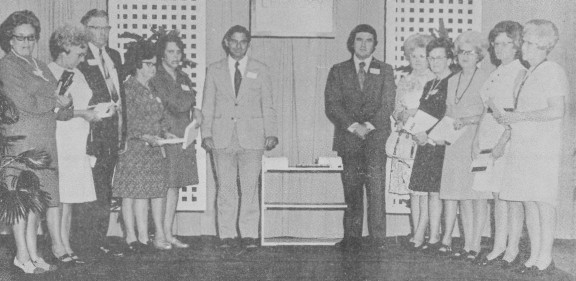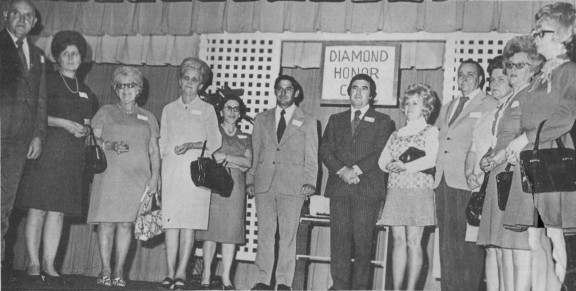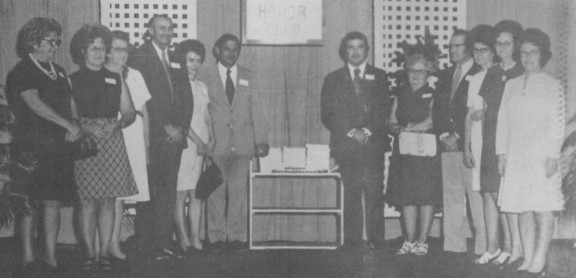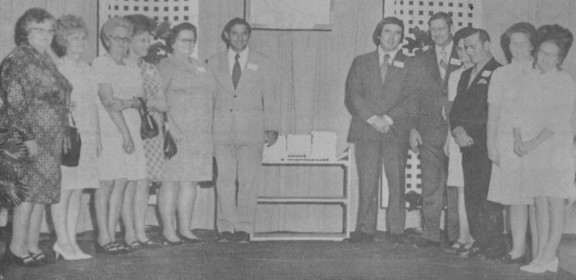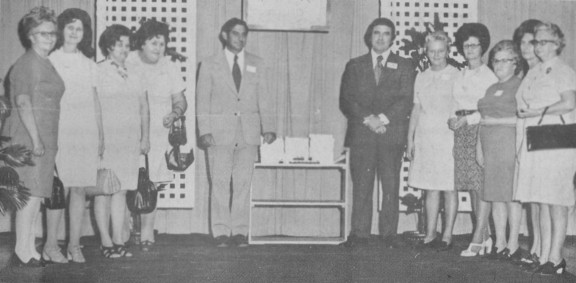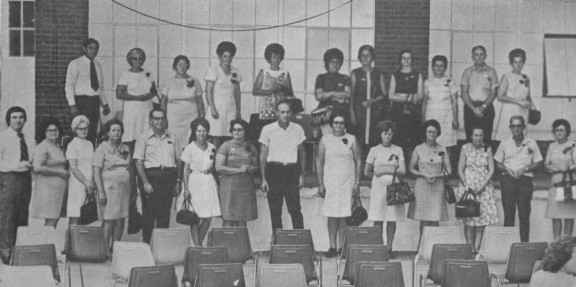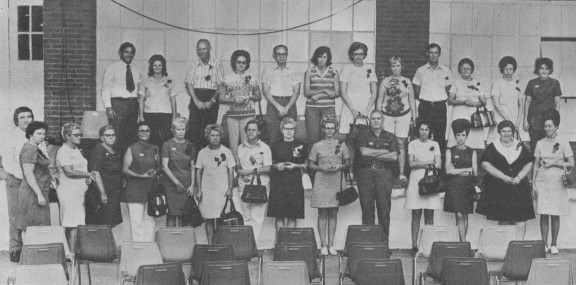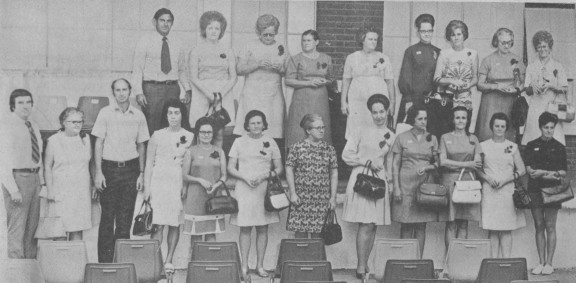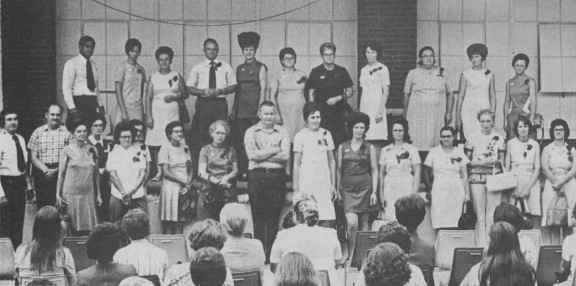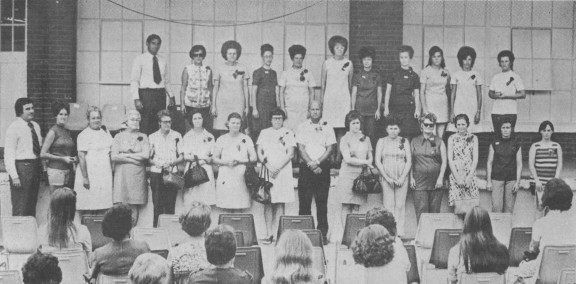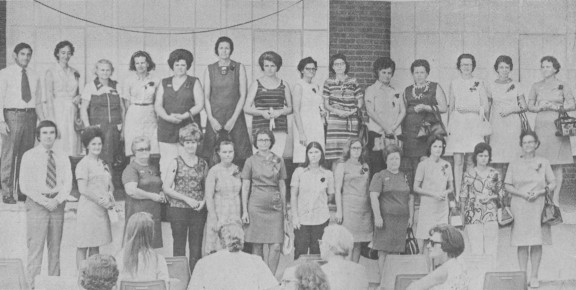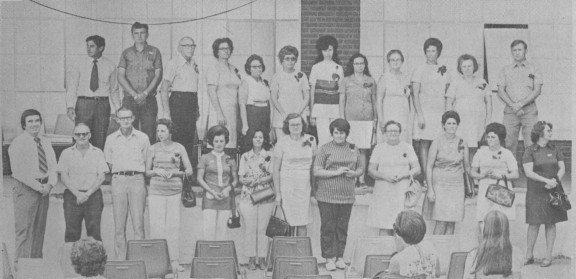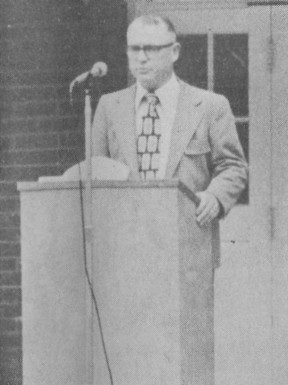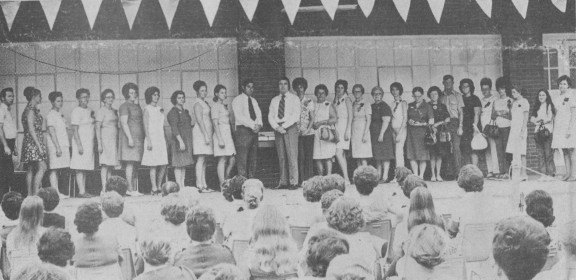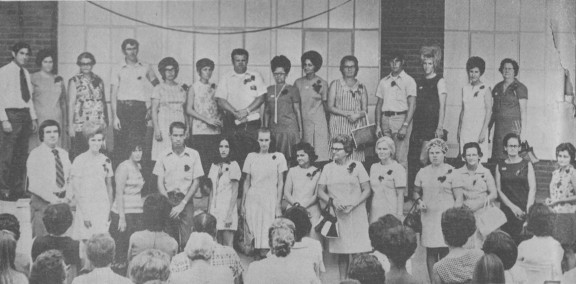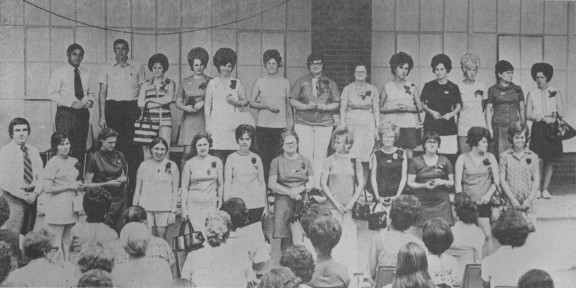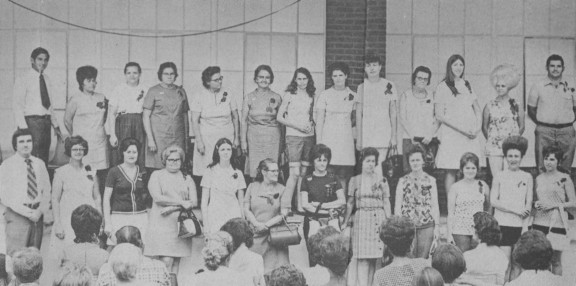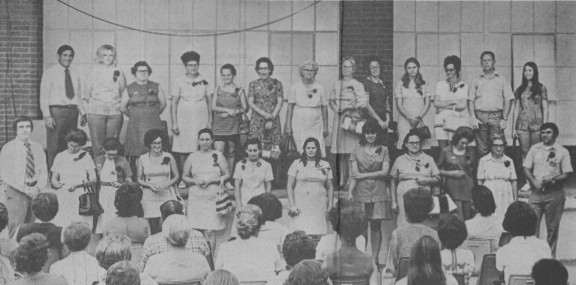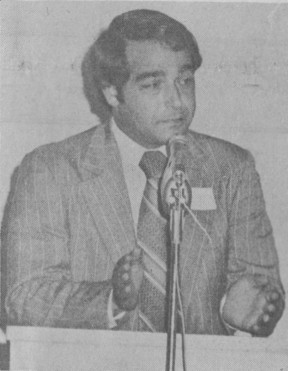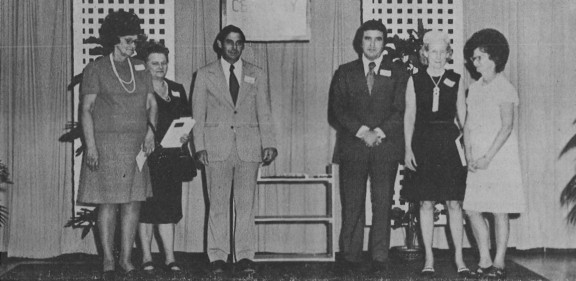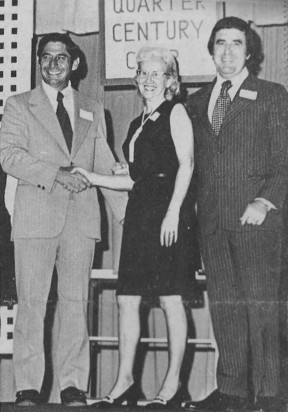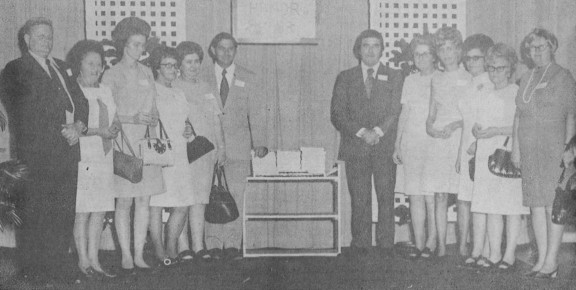Jeremy Williams’ Interviews With Shirt Factory Employees - Part 1
The following is taken from information prepared in November, 2008, by Jeremy W. Williams of Cookeville for a History class at Tennessee Tech taught by Dr. Michael Birdwell. Jeremy is the husband of Katie (Winningham) Williams, and is the son-in-law of David and Kathy Winningham of Livingston. I am most appreciative to Jeremy for his willingness to share this information.
"In 1944, a shirt factory opened its doors in Livingston, Tennessee. It was located on South Church Street just off the courthouse square. Its first location was in a mule barn before a permanent structure was built. Several local women went to work for the first time in a manufacturing facility. To gain perspective on what it was like to work at the shirt factory, several interviews were conducted with former shirt factory employees.
"Ms. Hazel Webb was kind enough to share her insight and prospective for the purpose of this paper. She is a native of Overton County and a wealth of knowledge on many subjects involving the history of Livingston. Ms. Webb worked for forty one years at the shirt factory and was there from the very early years of operation. Ms. Webb's employee number was twenty-six. When she started work, the shirt factory was a large supplier of shirts for the military. The shirts were tailored to military specifications and worn by World War II soldiers. Ms. Webb began her first years of employment in the hemming department. She and others earned around forty cents per hour. When she finally retired forty one years later as a production supervisor, she was taking home roughly six dollars an hour. During her early years of employment, there were no benefits, 401K, pension, or any type of workers insurance. They were tough, determined, and just happy to have employment in those early years.
"The shirt factory ran one shift until the 1970’s then they began running two shifts per day. Even in the 1970’s, the factory would look much different than its modern counterparts of today. The factory was closed in with few open windows or doors. It was not just poorly ventilated, but not vented at all. The lack of vents in the building made work challenging for the employees because of the blizzard of lint that was constantly floating through the air. During the summer months, the front doors would be opened and a large floor fan placed there to help cool the facility. Unfortunately, this little bit of relief from the heat only caused the lint and dust problem to worsen. The factory also had an oiled wooden floor and which, coupled with the lint, and could make for quite a fire hazard. In fact, on June 10, 1949, a storage room in the facility caught fire and was severely damaged. It was estimated that 8,490 army shirts were destroyed and damages topped $60,000.
"In Ms. Webb's opinion, the shirt factory’s presence in Livingston was one of the most socially beneficial things that had occurred in her lifetime in the city of Livingston. She described how most of the employees for the first time had substantial amounts of disposable income to spend. She remembers that she and many of her co-workers bought their first electric stoves, refrigerators, and other modern appliances from Puckett’s Furniture, Appliances, and Gifts. Many other businesses also had an increase in income from the increased sales. She also remarked that they where able to better feed, cloth, and care for their families with the new income source. Ms. Webb felt that if the factory had never come to Livingston, the city would not have developed as well as it did. She pointed out that cities and counties received an increase in tax revenues that helped develop utilities and public infrastructure such as roads, electricity, hospitals, and schools that most of us take for granted today.
"One of Ms. Hazel Webb's intriguing recollections took place during a unionization push at the factory. She told her story like it happened just yesterday and in great detail. In the late forties, a group of union miners where trying to set-up shop in the Livingston shirt factory. They had come "down from the mountain" and were standing outside the facility. In a hostile manner, they were telling the workers they better join if they knew what was good for them. Ms. Webb felt this was a poor way to try to win the employee support. The vote to unionize had recently failed and several from the union were picketing out in front of the factory. Ms. Webb was felt they were with in their rights to picket and try to organize, but they went too far. The picketers began to harass, insult, and block entry of workers just trying to go to work. As she experienced this first hand when one morning she was trying to hand in her production totals to her supervisors one morning and was confronted by an unknown to female picketer. The picketing lady keep stepping in front of Ms. Webb and began shouting at her something similar to, "can't you read, there is a strike on here, you ain't going in there, can't you read hillbilly". At that point, Ms. Webb said she punched her square on the chin and dropped her right there then climbed on her and gave her a few more punches before some of her co-workers pulled her off. After that, Ms. Webb and her fellow workers walked in and worked out their day. She said after that event she was never given any trouble by the people pushing for a union and that in the years that followed, the shirt factory never unionized. One could assume that this event provides hours of laugher and good natured ribbing for Ms. Webb and her friends.
"Another interesting person who worked at the shirt factory was Ms. Clara Hunter. Ms. Hunter is also a native of Overton county and spent several years of the employment in the Livingston shirt factory. She brought an interesting perspective to the shirt factory subject because she worked for the factory on and off over the span of three decades. Ms. Hunter first started working the shirt factory in 1949 earning an hourly wage of sixty cents. She was employed until her husband who was in the armed services was transferred to another location in 1951. Throughout their marriage, she and her husband moved several times to different states, primarily Florida. They returned to Livingston in 1955 and she once again took up employment at shirt factory for another four years until once again they were relocated. They returned to Livingston for the final time in 1967. Ms. Hunter was hired for the third time and stayed on until 1969.
"According to Ms. Hunter, even in 1949 employees were given their first raises after thirty days of work and would see their wages increase to seventy-five cents per hour. This may seem very meager, but for anyone that has held employment with a contemporary corporation, they usually wait at least ninety days before they give a first raise. In 1950, she remembers the company leader’s announcement that employee wages would be raised that year to at least one dollar an hour. Ms. Hunter was quick to point out this was not out of generosity on the part of her employer, but a result of the federally mandated raise in the minimum wage.
"During her years at the shirt factory, Ms. Hunter worked mostly in the pressing department and spent most of her time rolling collars. This department was located in the downstairs or the basement area of the factory. She and her fellow employees worked at least forty hours a week with industrial steaming equipment. To say conditions were extremely hot and muggy during the summer months with no ventilation and the heat radiating from their equipment would be an under statement. Though conditions were tough, to say that they were unbearable would certainly be a misstatement because many worked in these conditions day after day for years.
"Ms. Hunter was clear that working for the shirt factory was not something she regrets then or now. She was proud to have a job and took pride in her work. The shirt factory was the first major industrial facility in the area that she could recall, especially one in which the vast majority of employees were women. By Ms. Hunter’s estimations, more than ninety percent of the shirt factory employees were women. The fact that the shirt factory employed so many women is of great historical importance to Overton County and the surrounding area.
"Ms. Hunter remembered the first thing she ever bought with her earnings was a large cedar chest for five dollars. She mentioned that many of her co-workers were able for the first time to purchase consumer goods such as washing machines, electric stoves, and even some purchased their first cars. She was one of them and proud of it."
Jeremy Williams’ Interviews Shirt Factory Employees - Part 2
The following is Part Two of Jeremy W. Williams’ paper he prepared on the history of the Livingston Shirt Factory. It picks up with his interview with Ms. Bobbie Maynord.
"Another longstanding Livingston shirt factory employee was Ms. Bobbie Maynord. Ms. Maynord stated she worked for the shirt factory for forty-eight years. She began in 1953 and recalled her first paycheck for a two week period was around forty-two dollars. She remembers receiving that first paycheck was one of the proudest moments of her life. Ms. Maynord spent her years at the shirt factory sewing on sleeves in the main area of the factory. When she finally retired years later she was making a little over five dollars per hour.
"Ms. Maynord also mentioned that shirt factory work was extremely hot and with difficult working conditions. She stated that "even in the dead of winter, a person could break a sweat just by standing still." However, she did recall that toward the end of the shirt factory’s existence, the owners finally did install air conditioning in the factory. Air conditioning, considered a luxury in the 1960’s and 1970’s, had finally become economically feasible. Ms. Maynord remembered the attempts to unionize and voting on the matter at different times during her employment. She felt that the union never took hold in the shirt factory because the employees were treated fairly and honestly by the management. Every time the vote came up for unionization, it quickly received an overwhelming majority of nay votes. Ms. Maynord reiterated that conditions in the factory where tough, but that life itself in those days was tough
"Ms. Maynard did share a disheartening account of how shirt factory employees were treated that came from an unsuspecting source. It was not from the owners, managers, or even the failed unionizers, but from some of the female town’s people. She made it clear this was not mind set of the majority, but there were several, whom she would not name, that looked down on the employees of shirt factory. She came to this conclusion by how people would look at them. There were also episodes snickering, whispering, and similar forms of treatment. She felt that some of these people unjustly saw them as second class citizens. Ms. Maynord said that this ignorance had little effect on her, but she felt that there were a few that worked there that may have felt ashamed or embarrassed that they worked at the shirt factory. Ms. Maynord never truly understood where this mentality originated from or why. She laughingly said, "We were not the most socially refined or affluent group, but we were ordinary hard working country folk and proud of it."
"This mindset is not surprising especially for anyone who has ever toiled at a less than glamorous job such as a restaurant server, a gas station attendant, or manual laborer. This type of ignorance is far separated from reality. If the so called upper class had any real understanding of basic economics, they should have been thanking the men and women who worked in the factory. Their new purchasing power caused more small businesses to be created and existing businesses to thrive. With this in mind, there were several businessmen that purchased one thousand dollar tax free bonds from the town of Livingston to support an expansion of the shirt factory sometime between 1952 and 1956. The bonds were used to finance an addition to the factory so more employees and production capacity could be added.
"There were other businesses that popped up just to service the needs of the shirt factory workers. There were numerous shuttle services that carried employees to and from the factory to many of the surrounding communities. Many of the employees did not have their own car and would literally pile in the back of trucks or stack-up in cars to get to work. Some people even purchased small buses to haul workers in from the Allons and Independence communities. Some of the classical economic models claim that for every industrial job that exists that there are two or three in the service sector that pop up. Ms. Maynord’s husband had a television business that serviced and sold television sets to a majority of her co-workers. These examples display the economic importance and historical significance the factory played in strengthening the Livingston community.
"Ms. Opel Walker, a native of Rickman, worked for the Livingston shirt factory from its very inception in 1944 when she was only sixteen years old. At the beginning of her employment, she did not work in the big red brick building that later workers would recognize as the shirt factory. Instead, she said the first production took place in the old mule barns. One barn was used for production and one was used to store finished goods. During those early days, sales people would load up an old horse drawn wagon with shirts and push it up to the square to sell out of it. Within in a couple of years, the production moved to its longstanding facility on South Church Street.
"Ms. Walker shared some more detail on the work conditions in the shirt factory. In the beginning, their only bathroom was an out house that all employees shared. One can only imagine the pungent aroma that arose from it during those hot summer days. The heat was the first thing that Ms. Walker drew from her memory. She also described the first fan that they installed to help combat the heat. This was not a fan that was purchased, but one that they crafted themselves. The conveyor belt that ran through the center of the factory was rigged by the employees with rectangular pieces of cardboard tethered to the bottom of the belt. As the conveyor would pass overhead, it would bring a little breeze of relief. However, this improvised central cardboard fan only worsened the lint problem. She quickly pointed out how it was better than nothing and made the conditions more bearable.
"When Ms. Walker began her employment in 1944, she made around thirty cents an hour. She remained with the factory for twenty seven years. She and the others in those days labored forty hours for less than a dollar per hour until the minimum wage was implemented at one dollar in the 1950s. Ms. Walker has a very good grasp of how the monetary system works. She stated that in the 1940’s, a dollar possessed a greater purchasing power than it does these days. She continued stating that inflation is devaluation of a currency by reckless printing of money by the government, and that the high prices we deal with today is a result of the loss of purchasing power. Many people in our society these days believe that inflation in an increase in the worth of the object they are buying, but Ms. Opel has not fallen for this logic.
"Ms. Opel Walker, like other women that were interviewed, enjoyed working at the shirt factory. She saw it as just one big extended family and one where everybody got along. She said everybody was just proud to have a job and did not mind working hard everyday. Once again, the description of simple country people was used to describe the majority of shirt factory employees.
"When asked about the attempts for unionization, Ms. Walker stated that they had no reason for a union. She remembered her employer as fair, honest, and understanding. There were conflicts, she stated, but nothing that was major enough come to mind. Ms. Walker also confirmed the story of the one punch knockout that Ms. Webb gave to a less than polite picketer. Ms. Walker said she was right there behind her and witnessed first hand and it’s a story that has brought them laughter and good memories for years.
"Ms. Walker also confirmed that she did perceive there was a second class citizenship placed upon the employees of shirt factory. She felt as though some townspeople thought the shirt factory employees were "a trashy lower class of hill folk." Ms. Walker mentioned that some of high-headedness came from a few of the merchants in Livingston. She stated it was how they were treated or the lack of service given them when they went into some of the stores. With a loud laugh, she exclaimed "they did not mind taking our money," and it seemed that they saw little difference in money earned from working in the factory. This unfortunate piece of their shared history shows how little we have changed from those days and like today, there are those who are thought to be of less value because of their lower socioeconomic standing.
"Finally, Mr. Frank Martin took time to share his experience with the Livingston shirt factory. Mr. Martin began working at the factory in latter months of 1952 and remained employed there until 1979. He remembered that when he started at the factory, his hourly wage was around seventy-five cents per hour, which was below the federal minimum wage at the time. Mr. Martin’s first job at the shirt factory was in the service department and first title was that of "bundle boy." Mr. Martin then went to work in the shipping department as a low ranking staff member then rose to assistant shipping manager and finally finished out his employment with the shirt factory as the shipping department manager. Mr. Martin’s promotions continued as he became vice-president of production operations and then president of production. Mr. Martin talked how he is a true believer in self-determination; that anybody do just about anything as long as he or she puts a hundred percent of themselves into what they are doing. This is how Mr. Martin always looked at life. He also felt that speed was not as important as long as he did every task the best he could.
"In regard to working conditions, Mr. Martin mentioned that the heat was a hard everyday reality for the workers, but they all pushed on and did the jobs they were hired to do. Mr. Martin felt that the downstairs steaming area during the summer was hottest place in the factory. For this reason, when the shirt factory finally installed air conditioning in the 1970's. Mr. Martin said the management understood the work was hard because they had done many of the jobs they later supervised. Mr. Martin estimated that at its peak, the Livingston Shirt Factory employed over 1,500 people. This made the factory, according to him, the largest shirt factory under one roof in the entire United States. During the peak years, the factory made over three hundred different styles or models of shirts. The shirt factory also ventured into light jackets, robes, and for a time even swim wear.
"Mr. Martin reflected that his years at the shirt factory were some of the best in his life. He feels that part of Livingston left when the shirt factory shut down in 1984. He wholeheartedly believes that Livingston was made better by having the shirt factory a part of its history, whether forgotten or not.
"In its forty year history, the Livingston shirt factory, under its many different labels and names, employed thousands of residents of the Upper Cumberland Area. The shirt factory gave the rural class of this area the chance to increase socioeconomic standing. Many of these people were able to buy homes or put heir children through college as a result of their persistent hard work. Most did this without complaint and without many of the modern worker benefits. These workers, who toiled away in conditions that most would not tolerate today, are a testament to and treasure of the State of Tennessee."
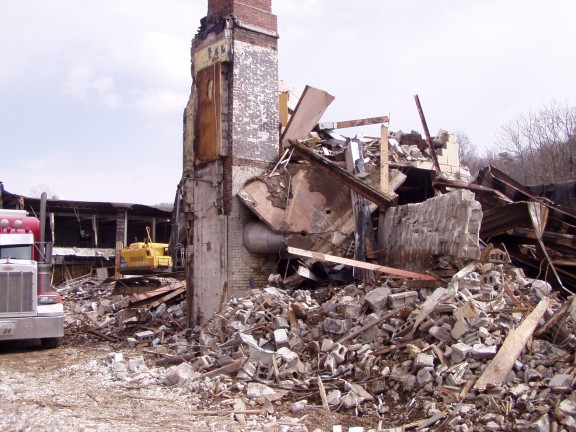

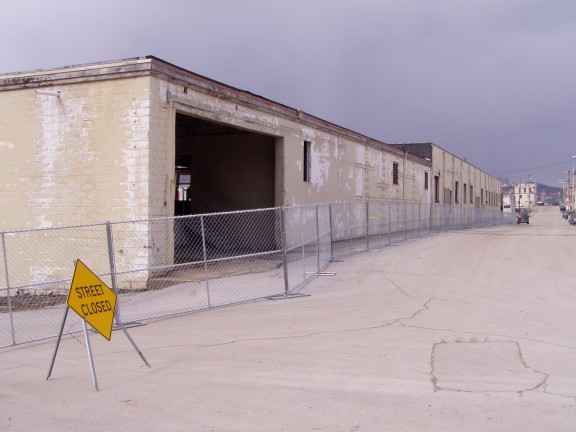

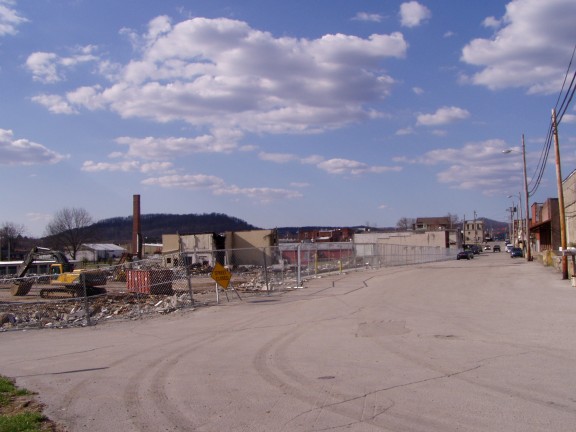
Pictures from the shirt factory days

